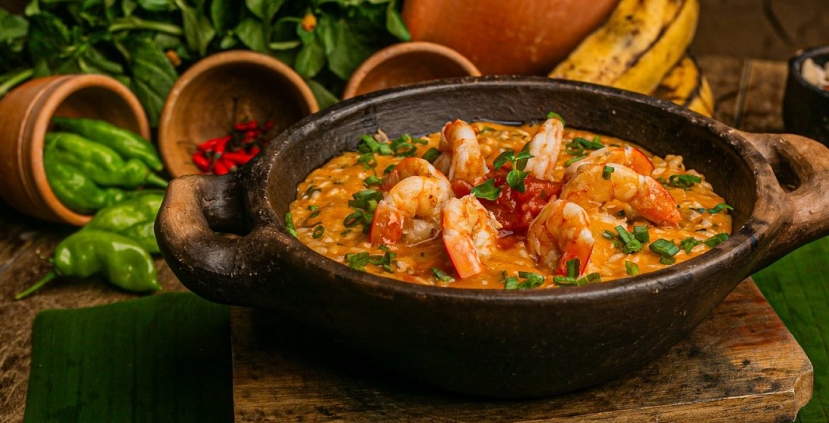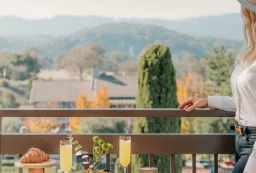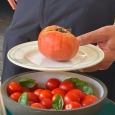
It’s been a few years since the once-obscure açai berry went global. It is revered as a nutrition-packed “superfood,” commonly consumed as a breakfast or frozen dessert treat served up like a sundae. While it has added extra mystique to Brazil and the Amazon Rain Forest, anybody visiting Brazil’s Para State learns quickly that this native berry is consumed in a very different way, as a heated puree that enhances the many varieties of locally-caught river fish, such as prepared deep-fried or grilled.

There is more to Para State’s natural bounty than açai. Capital city Belèm’s Mercado Ver-o-Peso, the largest food and produce market in Latin America, is a perfect place to learn about why “the gateway to the Amazon” and why this region is one of the cradles of Brazilian cuisine. You will find jambu, a mouth-numbing watercress-like leaf, cupuaçu, a rich fruit related to cacao, and tucupi, a fermented seasoning sauce and by-product of cassava flour. One building is dedicated to freshwater seafood and fish including pirarucu, dourada, tambaqui, and tucunaré, all of them excellent fried, stewed, or grilled with just a bit of salt, pepper, and citrus. At some boieira (food kiosks) like Barraca do Loro, the servers will teach visitors the locally approved way to consume açai: Take a mouthful of the purple puree and follow it immediately with a bite of fish or a protein of choice.

The lively Velha neighborhood location of Belèm institution Point do Açai provides an excellent introduction to Para’s time-tested dishes. Favorite appetizers include fried pirarucu balls and unha de caranguejo, a potato or casava dough snack stuffed with crabmeat. Carnivores will gravitate toward hearty maniçoba, a beef stew with pork sausage and cassava leaves. Three- and six-dish samplers allow diners to try the Para essentials, including moqueca, a fish stew, tacaca, a soup with shrimp and a casava and tucupi base, and vatapá, an Afro-Brazilian dish with wheat, shrimp, and regional seasonings. The original recipe cocktail to try is a caipirinha with its house-blended tangerine lemon juice, which pairs nicely with its fried fish accompanied with savory açai. The standout dish is the “Chora Nos Meus Pés,” a delicate fish filet in a tucupi-cashew sauce teamed with jambu rice.
"There is more to Para State’s natural bounty than açai. "
However, it is Santarèm, an hour’s flight from Belèm, where adventurous foodies will uncover Para State’s culinary gold. At the more upscale restaurants, the chefs and cooks bring modern twists to time-tested recipes while endeavoring to maintain the integrity of the ingredients. As soon as the plane lands, diners will not only venture into the Amazon jungle’s natural bounty but also the wonders of the culinary landscape beyond the small purple berry. This includes numerous uses of casava/manioc flour and rare fruits such as cupuaçu, related to cacao, with a rich, fruity flavor and a high-fat content. Passionfruit, a favorite across Brazil, is known locally as maracuja and used in some regionally specific ways not found in the larger metropolises.

Just outside Santarèm’s city center and its waterfront, Piracema is both physically and gastronomically a ray of sunshine, and described by its owners as “a love letter to our Amazon.” The cheerful yellow interiors bring added sophistication to its use of regional handcrafts while its produce-heavy menu is filled with vegetarian options, salads, and chilled ceviche not often found on other menus of the region. Its pirarucu defumado, smoked pirarucú made by co-owner “Dona Vera” is one of the star attractions. However, under the direction of Restauratrice Polyana Reça, the elevated treatment of shrimp, tambaqui, filhote, surubim, and fresh pirarucú, fried, baked, and sauteed, are perfectly presented in both main courses and appetizers.

Although celebrity chef Saulo Jennings’ “Casa do Saulo” has locations in Belem and Rio de Janeiro, his Casa do Saulo Tapajós is the location worth tracking down because of its indoor-outdoor layout and the way the setting frames his elevated take on the food he grew up with. Before one gets to the table, the layout tells a big part of Jennings’ story, from the chef’s garden to the beach club setting, and panoramic beachfront views that read as “ocean” more than “river.” Jennings describes his menu as Tapajônica cuisine, inspired by his parents’ culinary creativity as well as micro-regional ingredients such as Santarém beans, aviu (shrimp mainly found in the Tapajós region), and tempting tapas made with either manioc or piracuí flour, made from dried salted fish.

Among Jennings’ beautifully plated appetizers and main courses, the rich, garlic-y Camarao ao Alho e Azeite served with rustic bread and Camarao Caboco, six large shrimp breaded in cassava, tapioca, or bread flour served with a honey dipping sauce are both approachable and delightfully different. Other delectable appetizers include a crab coxinha, a stuffed teardrop-shaped appetizer breaded in panko crumbs, fried isca de peixe, tapioca cubes with cuperaçu jelly and cheese, artisanal sausages, steak strips, and an Italian burrata starter. If there’s any main course that falls into the “must try” category, it’s Jennings’ signature Casa do Saulo fish topped with shrimp, plantains, garlic, scallions, and a creamy sauce. The menu says it’s for two people, but it may take as many as six or seven people to clean the metal dish it is served in.

"At the more upscale restaurants in Santarèm, the chefs and cooks bring modern twists to time-tested recipes while endeavoring to maintain the integrity of the ingredients."

Perched in a prime spot along Alter do Chao’s beachfront road, Ty Comedoria e Bar is so polished and stylized that it is safe to assume it was created more for travelers than local diners. Even with a fair share of international travelers occupying the fashionable space, citizens’ review pages make it clear that people who live in Santarém also frequent the place and love the contemporary cocktails, artfully plated main courses, use of local ingredients like Santarém beans and slyly inserted European touches. Boto Gelato, opposite the town’s main square, has to be experienced at least once because of its ice cream and sorbets crafted with distinctively regional flavors, including a sweet-and-sour açai sorbet, jambu sorbet, Perola/Pearl do Tapajos, Cumaro, passionfruit cheesecake, and Treme Treme with cupuaçu, jambu, passion fruit, and pimento peppers with a silky consistency.

If time allows, an organized tour through the Jari Canal to Jardim Vitória-Régia is as fascinating for its unusual edibles as it is for its dramatic landscape. En route, travelers are instantly immersed into a completely different land and waterscape than the jungle foliage around Alter do Chao. At the end of the passage, they emerge into a clearing with over 130 giant water lilies surrounding a small house on stilts. Here, owner Dulce Oliveira brings her vision of an Amazon conservation site to life, serving up an actual taste of what water lilies have to offer beyond their beauty as they are classified as “PANCs,” or “Non-Conventional Edible Plants.” Once guests are seated at a table with a view right out of an Impressionist painting, Oliviera brings out two trays of sweet and savory snacks including savory chips, pickles, tempura, peanut brittle, brownies, and churro-like bites made from stems, seeds, flowers, and leaves that are high in antioxidants and protein.

Food will always be a part of the culture no matter where one travels in the world. What makes this corner of Brazil so compelling, however, is observing how the building blocks of local recipes shape the Amazonian lifestyle and vice versa.
















